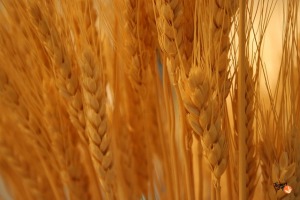Wheat
Farmer’s Coop elevator received its first load of wheat at the Hemingford location on Sunday July 12 kicking off the 2015 harvest season. Tuesday July 14 concluded with slightly more than 100 trucks of wheat being dumped at the Hemingford location before 2-3 inches of rain made barely dry fields impassable for the rest of the week. Protein levels are averaging 11% and test weights 60 pounds per bushel.
We are ready to receive wheat at all Farmer’s Coop locations and we plan on operating longer hours. So far the season is off to a slow start so I would recommend calling ahead if you want to get a sample done or dump a truck in the late evenings or on weekends just to make sure someone will be there.
Combines, grain carts, and trucks have come out of the woodwork and can be found sitting and waiting for things to dry out in order to start combining. There is word that there is wheat ready to harvest in South Dakota and Montana and many of the harvesters are continuing their journey north without even stopping in Nebraska. There are concerns in Kansas with the levels of vomitoxin in the wheat due to high moisture levels this season. Farmer’s Coop has sent many samples to be tested and vomitoxin is present but not in high enough levels to cause concern. More can be read about vomitoxin in the article below.
US wheat is currently over-priced when compared to the rest of the world. Mexico, one of our biggest customers, bought wheat from France last week. The dollar is higher and crude oil is lower and the combination of these events is a bad sign for wheat. There has also been beneficial rains in dry areas in Canada and Russia that have improved the wheat crop outlook in those areas.
Corn
There is controversy over the USDA yield and production estimates for 2015 corn production. Areas in Iowa, Missouri, and southern Indiana are still receiving harmful rains that are negatively impacting corn production. Meanwhile, there are good growing conditions in the Midwest as corn enters tasseling. The high variability in weather and corn condition across the country has resulted in a wide range of production predictions. Trade is highly sensitive to any changes in corn yield so there will most likely be major activity around USDA reports. Actual yield may not be truly known until harvest is done.
There is very little news for the market today after the weekend which is limiting trade in both directions. The cash market is very mixed with many buyers claiming that they have filled their needs for the next several weeks. Many traders are holding losing positions at this point after offsetting their shorts or buying longs during last week’s rally. This could be bearish for futures prices.


You must be logged in to post a comment.